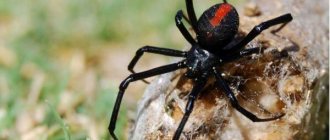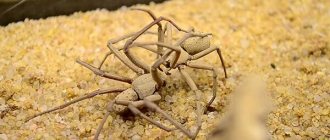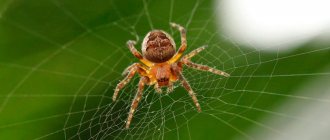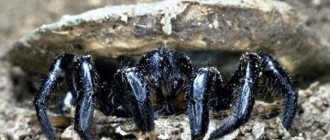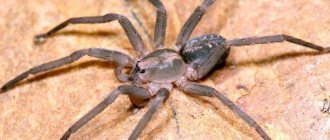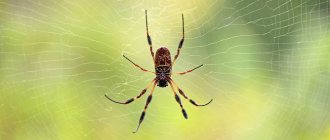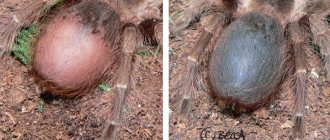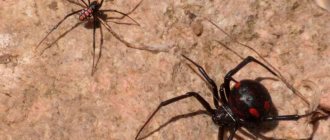When you imagine the largest animal in the world, the blue whale or elephant immediately comes to mind. But you will never think about the largest crustacean. Most people don't even know it exists, but this creature lives on the seabed and is called the Japanese spider crab. It is rumored that the legs of this crab can reach a length of 4 meters. Can a crab with four-meter legs really exist?
Description of the spider crab
The largest arthropod has a strong calcified carapace (carapace), which is only 37-45 cm, but if you measure its length from one leg with claw to the other, it will be up to 4 meters. The round or pear-shaped body is covered with spiny, short tubercles of dark orange or light brown color, which remains unchanged throughout life. Two thin spines protruding above the head, like growths, serve as protection from sea predators. The creature lives for more than 50 years (there is an assumption that in the natural environment they can live for a century), the weight of some individuals reaches 20 kg.
The unusual Japanese animal has 10 thin and long legs that grow throughout its life. They end with sharp claws (in males they reach 40 cm), help to climb stones and cling to them. Predators and trawler nets often cause spider crabs to lose limbs. Research by scientists has shown that 3/4 of crabs do not have one or more limbs, but the arachnid survives even without 3 legs.
Reproduction
The mating season for Macrocheira kaempferi begins in January and lasts until April. During this period, sexually mature (reaching 10 years of age) crustaceans rise to a depth of 50 meters. They do not exhibit mating behavior; the male spider simply injects sperm with spermatophores into the abdominal cavity of the female.
All data on reproductive development is taken from laboratory studies, there is very little information on reproduction in the natural habitat. Some time after internal fertilization, the female can lay eggs within 10 days; due to the low survival rate, their number reaches one and a half million, with a diameter of 0.63 to 0.85 mm.
The female carries the future offspring on her back and abdomen, raking the water with her feet, saturating the eggs with oxygen. The mother takes care of the eggs until the small larvae hatch, after which parental involvement ceases completely and they are left to fend for themselves. Not all small creatures survive to the stage of tiny crabs; this will take 55-72 days.
During the mating season, catching the unusual Japanese crustacean is prohibited.
Interesting Features of Coconut Crab
Thanks to special organs located on the antennae, which determine the direction of the smell and its concentration, the coconut crab, unlike its crustacean relatives, has an excellent sense of smell. Like any crab, it has tactile receptors: hairs and bristles of varying lengths. In addition, it has olfactory organs, which the rest of its brothers lack. Their presence is due to the specific developmental features of the palm thief, which at one point was unable to exist in the water and moved to live on land. Being hungry, he hears his prey even at a distance of several kilometers.
“Palm thief” - the coconut crab received its second name for its love of everything shiny. If on the path of an arthropod any shiny object is encountered (be it a spoon, fork, metal utensil, household utensils or something more attractive), the crab will not crawl past and will definitely profit from an interesting find (even if the latter is completely inedible), which it will drag into its crab den.
Appearance
The rainbow red crab's structure most closely resembles an ordinary representative of the order of decapod crustaceans. It stands out primarily for its color: bright, attractive and unusual. The crab's shell is dark blue, its legs are orange or red, and its large claws are gray or bluish. The abdomen, in contrast to the back, is pale white with bluish-blue veins. The diameter of the red crab's shell usually reaches 20 centimeters.
The rainbow species received many names precisely because of its color. According to scientific classification, in Latin it is called Cardisoma armatum, in English speakers it is called patriot, indigo, tricolor. Due to its terrestrial lifestyle, this rainbow red crab is often called a terrestrial crab.
Origin of the species and description
Photo: Spider Crab
The Japanese spider crab (タカアシガニ or "long-legged crab"), or Macrocheira kaempferi, is a species of sea crab native to the waters around Japan. It has the longest legs of any arthropod. It is a fishery item and considered a delicacy. Two fossil species have been discovered belonging to the same genus, ginzanensis and yabei, both found during the Miocene period in Japan.
Video: Spider Crab
There was much controversy during the classification of the species based on larvae and adults. Some scientists support the theory of a separate family for this species and believe that further research is needed. Today the species is the only known surviving member of the Macrocheira, and is considered one of the earliest branching members of the Majidae. For this reason, it is often called a living fossil.
In addition to one extant species, a number of fossils are known to have once belonged to the genus Macrocheira:
- Macrocheira sp. — Pliocene Takanabe Formation, Japan;
- M. ginzanensis - Miocene form of ginzan, Japan;
- M. Yabei - Miocene Yonekawa Formation, Japan;
- M. teglandi - Oligocene, east of Twin River, Washington, USA.
The spider crab was first described in 1836 by Coenraad Jacob Temminck under the name Maja kaempferi, based on material collected near the artificial island of Dejima by Philipp von Siebold. The specific epithet was given in memory of Engelbert Kaempfer, a naturalist from Germany who lived in Japan from 1690 to 1692. In 1839 the species was placed in a new subgenus, Macrocheira.
This subgenus was elevated to genus in 1886 by Edward J. Myers. The spider crab (M. kaempferi) has been placed in the family Inachidae, but does not fit neatly into this group, and it may be necessary to create a new family exclusively for the genus Macrocheira.
Features of character and lifestyle
Photo: Sea spider crab
Spider crabs are very quiet creatures that spend most of their days searching for food. They wander along the seabed, moving easily over rocks and potholes. But this sea animal cannot swim at all. Crab spiders use their claws to tear apart objects and attach them to their shell. The older they get, the larger their size. These spider crabs shed their shells, and new ones grow even larger as they age.
One of the largest spider crabs ever caught was only forty years old, so there's no telling what size they might be when they reach 100 years old!
Little is known about how spider crabs communicate with each other. They often forage alone and there is little contact between members of this species, even when isolated and kept in aquariums. Because these crabs are not active hunters and do not have many predators, their sensory systems are not as acute as those of many other decapods from the same region. In Suruga Bay, at a depth of 300 meters, where the temperature is about 10°C, only adult individuals can be found.
The Japanese variety of crabs belongs to the group of so-called “decorator crabs”. These crabs are so named because they collect various objects in their environment and cover their shells with them as camouflage or protection.
What's special about it
The Huntsman spider family is very numerous: it includes 1090 species. They can most often be found in the tropics; there are isolated species in the Palearctic.
Giant crab spider - Olios giganteus
The giant crab spider is the largest member of the family. He is an inhabitant of Australia, which has many unique species of insects, animals and reptiles. There are 155 species of huntsman spiders recorded on the continent, but this one is the largest of them all.
Appearance
This arthropod cannot be confused with anyone else: the length of the limbs reaches 30 cm. True, only females can boast of such a size.
Giant crab spider
Males are 2 times smaller, but 15 cm is also a lot for a spider. In size and weight it is second only to the goliath tarantula, ranking 2nd in the world according to these indicators.
Goliath tarantula
Some researchers believe that the giant crab spider is the largest.
It also has other features that allow you to accurately identify the insect:
- unusually curved long hairy limbs, for which it received the name crab, allow it to move not only forward, but also sideways;
- the pubescent body up to 4.6 cm long may have a grayish, light brown or black color;
- 8 eyes located on the sides of the cephalothorax in 2 rows provide excellent all-round visibility;
- The giant crab spider is no different in visual acuity - it sees only moving silhouettes and shadows;
- powerful jaws allow you to cope with even small rodents.
In order to turn its legs 180 degrees and plunge its jaws into its prey, the spider only needs 1/8 of a second - amazing speed! A photo of a crab spider will allow you to estimate the size of the insect and examine it in all details.
How does a giant spider live and hunt?
The crab spider prefers to live in trees, crevices in stones, and sometimes hides under fallen leaves or behind loose tree bark.
In rainy weather, this giant can “visit” a person’s home - the special structure of its legs allows it to crawl through even a narrow crack.
Giant crab spider on the wall of a house
He feels at ease there. The owner is not particularly shy, hides behind the curtains or crawls along the walls, happily destroying domestic pests: there is a tangible benefit from the uninvited guest.
Unlike many other arachnids, the hunter does not catch his victims using a web, so he does not weave one.
However, the arthropod has a gland for spinning thread: with its help, the spider holds on to plant stems or tree branches while searching for food.
He prefers to hunt from ambush, patiently waiting for his prey:
- insects, including smaller relatives;
- lizards;
- frogs;
- rodents, however, he rarely catches them.
The prey is instantly paralyzed by the injected poison, and then fermented by the injected saliva, which makes it easier to digest.
Crab spider mouthparts
The Australian hunting spider moves very quickly, covering a whole meter in 1 second. He can not only run, but also jump high, overtaking the victim.
This representative of arachnids prefers a nocturnal lifestyle. Most often it lives alone, but sometimes you can observe a whole colony of insects gathered together and occupying a fallen tree or stump.
Reproduction
Mating is preceded by a period of courtship. After fertilization, the female is rarely aggressive, so most males are not in danger, unlike many other spider species. In order for the laid eggs to successfully turn into small spiderlings, they need a cocoon of cobwebs, which the female weaves.
Spider guarding its cocoon
She can lay up to 200 eggs in it. The female Huntsman spider is a caring mother: during the three weeks while the eggs are developing, she does not leave the cocoon and bravely protects it from enemies.
The spiderlings that have just emerged from the eggs are not yet fully developed and are absolutely helpless. At the nymph stage, they molt several times until a hard chitinous exoskeleton is formed, which spiders will shed repeatedly throughout their lives, acquiring a new one. After a few weeks, the young individuals become independent.
Hunting
Crab spiders spend a huge part of their time waiting for prey, sitting on flowers, sometimes on tree bark or on grass flooring. This type of spider does not weave webs to catch its breakfast; its main weapon is its front legs. They lie in wait for the victim in the bark of a tree, on flowers or in fallen leaves, after which they rush at it, using powerful front legs, biting the victim and injecting poison into it. The sidewalker can catch prey that is larger than itself and eat up to 4 large bees in just an hour. Another element of a successful hunt is the ability of the crab spider to completely merge with its environment.
Coconut crab: description
The coconut crab's body consists of two halves. The first is the cephalothorax with ten legs, which is the front part, the second half is the stomach. The front, most massive pair of legs is equipped with large claws, with the left claw being an order of magnitude larger than the right one. The next two pairs of legs, like those of other crabs, are powerful and large, ending in sharp ends. Thanks to them, crabs can easily overcome inclined or vertical surfaces. The fourth pair of legs is much smaller than the previous three and allows the young coconut crab to settle in coconut shells or mollusk shells for protection. By adults, the fourth pair is used for walking and mountaineering. The last pair of paws, the smallest and least developed (as well as the fourth pair), is usually hidden inside the shell. It is used by males for mating and by females to care for eggs.
Is the Australian hunting spider dangerous for humans?
The danger of the crab spider is often greatly exaggerated. The poison that he injects into his victim is not enough to seriously harm a person. But the powerful jaws make the bite very painful.
In addition to local manifestations - swelling and redness of the skin, general symptoms may also appear:
- headache;
- nausea or vomiting;
- diarrhea;
- tachycardia.
As a rule, no treatment is required - after a couple of days everything returns to normal.
Medical doctor
The danger can only lie in wait for allergy sufferers - it is better for them to consult a doctor.
Bites from this type of arachnid are rare, as they prefer to run away, leaving the battlefield behind the person. The only exceptions are females who protect their offspring - it is better not to approach them.
Those suffering from arachnophobia should also be wary of meeting a giant among spiders. It may well lead such people to a nervous breakdown.
Conclusion
The amazing nature of Australia has given the world many unique animals and insects. Among them is the large Australian huntsman spider.
It can be very scary for some, but there are cases when this insect has become a favorite pet. A person only benefits from such a neighborhood: there will definitely be no harmful insects in the house.
Blue crab
These crustaceans, like the Kamchatka crustaceans described above, are more likely not crabs, but craboids. They are called so for the blue spots on the sides of the carapace. Close relatives of the royal ones (even from the photo you can see that they are quite similar), they not only look approximately the same, but also have similar commercial value. When boiled, probably only a culinary guru or a chef at a restaurant specializing in seafood can distinguish them by taste.
Compared to the Kamchatka crab, the blue crab can live at lower temperatures, so in the places where they share their habitat, the blue crab goes deeper. The weight of this craboid is up to 5 kg, the size of the shell is up to 24 cm. A distinctive feature is the spines on top of the carapace.
Where does the crustacean monster live?
The coconut crab's habitat is exclusively terrestrial; an adult cannot live in water due to the fact that the gill lungs (something between gills and lungs) are adapted for breathing land air, despite the fact that such a respiratory organ contains tissues found in the gills. More precisely, the ability to exist in two environments (aquatic and terrestrial) is present at the initial life stage of the crab; as it grows, such an individual switches to a land lifestyle. In addition, these arthropods do not know how to swim at all and if they are in the water for more than an hour, they will definitely drown. The exception is when the coconut crab is still in the larval stage; in this case, the aquatic environment is native to him.
Coconut crab
As mentioned above, this land relative of crabs is more likely to be a hermit crab and has a second name - palm thief. Experts say: this is one of the largest arthropods on land. Its body length is 40 cm, the weight of an adult animal is up to four kilograms.
These large crustaceans were nicknamed palm thief for their tendency to steal. They say that, like magpies, they drag everything that is in bad shape and love shiny things. Coconut crabs are omnivores, they love pandans and coconut pulp, but they can also eat shellfish and small crustaceans. Mature males and females live on land, and eggs are laid in the water at high tide. Growing up, the young leave the water element.
Nutrition
The giant spider crab is an omnivorous scavenger. The crustacean rarely hunts, collecting dead, decaying remains of marine life and plants on the ocean floor. The monster's hunting trophies are small, slow-moving oceanic invertebrates. With their claws they deftly open mollusk shells and love to feast on live algae.
Experienced sailors tell horror stories about how a Japanese spider crab dragged a man underwater from the deck and then feasted on his body. Most likely this is just a scary story, but probably the arthropod will not refuse to taste human dead flesh.
Giant Baboon Spider
This type of arachnid is also called the Red Cameroon Baboon Spider. The spider is distinguished by the fact that its body is no less than 10 cm in size, and its limbs reach a length of about 20 cm. It represents the tarantula family and prefers to live in the tropics and subtropics of South America. It got its name because its limbs are similar to the paws of a baboon. The entire body, including the limbs, is covered with dense hairs of a dark gray color, transitioning to a distinct brown tint. Goes out hunting in the dark. The diet of this spider consists of its relatives, various insects, toads, lizards, etc. The spider is quite poisonous and its bite can be fatal to humans, although it does not attack people, but is able to defend itself in case of danger. In the event of a bite, a person experiences a painful shock, with vomiting and partial paralysis of the body. The spider is interesting because, in case of defense, it raises its front legs and makes sounds similar to the hiss of a snake. His appearance is truly terrifying. In addition, people should not anger this poisonous creature, but rather avoid it.
South Russian tarantula - the largest spider in Russia
Mizgir, or South Russian tarantula, is a characteristic representative of the wolf spider family. The body size of the female of this spider reaches three centimeters (the male's body is slightly shorter). The span of its legs, however, is considerable - 10-11 centimeters. It is widespread not only in Russia, but also in Central Asia.
Mizgir is characterized by shallow burrows in the sand or in the ground, which this spider digs itself and lines the inside with cobwebs. He spends daylight hours in them, but at night he can go out to hunt on the surface. Excellently sensing vibrations, the mizgir senses when a small insect approaches its shelter. Having brought its prey close, the spider instantly rushes at it and kills it. In winter, he deepens the hole and fills the entrance with earth.
This tarantula practically does not bite people. If a bite occurs, the pain and consequences are comparable to a hornet sting.
Giant Japanese spider crab and man
Harmless, with a rather good-natured character, the crab does not pose a danger to people. It plays a big role in the ecosystem - being a scavenger, the giant cleans the ocean floor from decay products, carries a sea sponge on its shell and provides it with drifting food.
https://youtube.com/watch?v=5nWc4B3xIbA
A significant reduction in catches over the past 40 years suggests that their population should be preserved and restored. Researchers propose growing the unusual Japanese creature in fish farms and replenishing the ocean with it. This outstanding relative of the crayfish must not be allowed to disappear from the face of planet Earth without a trace.
Behavior
In the ocean, arthropods become easy prey for squids and octopuses. The constant proximity of predators forces the crab to come up with new ways to survive. For this they call him a smart creature
He behaves very carefully, pays attention to little things that signal the appearance of an enemy. Deep-sea “spiders” are able to hide perfectly in any conditions. Some individuals grow tubercles containing poison on their shells, which paralyze aggressors.
Some individuals grow tubercles containing poison on their shells, which paralyze aggressors.
In aquariums, oceanariums, natural museums and nature reserves, where animals are cared for and food is supplied, arthropods are friendly and do not cause harm. This confirms the crab’s ability to learn and indicates that the animal adequately perceives the world around it and is able to adequately assess risks.
Usage
The meat quality of adult crab spiders is low. At great depths, dead animals become their main food product. Because of this, the meat tastes bitter. Adult “monsters” are caught in isolated cases. They are placed in aquariums and shown to visitors to aquariums.
Young animals are another matter. The meat of young crab spiders is tender. It is considered a delicacy. Catching young animals is not difficult at all. The abode of crabs is coastal waters. Here, hunters set traps with bait, where they easily catch individuals who have not gained sufficient life experience.
Thus, a significant number of young animals are exterminated without reaching maturity and without producing offspring. This raises serious concerns among experts. They are confident that the giant crab spider is in danger. If measures are not taken to protect it, the population will quickly decline to a critical level, or even disappear completely.
giant spider crab.
| TOP OF THE BIGGEST MONSTER CRABS. TOP BIGGEST MONSTERS. |
| TOP OF THE BIGGEST MONSTER CRABS. TOP BIGGEST MONSTERS. This video contains materials about the biggest caught... |
| Tags: |
| A Japanese spider crab has moulted in the Novosibirsk Oceanarium |
| Subscribe to new releases: Take a deep breath - the legendary TV presenter... |
| Tags: |
| An army of spider crabs marches across the seabed | Blue Planet II |
| A giant Spider Crab that should have 8 legs and 2 claws, but only has three. This brave soldier... |
| Tags: |
| Giant Spider Crab |
| At the San Diego Aquarium we watched a Japanese paw crab for six hours... |
| Tags: |
| How a giant crab molts: video |
| New series of your favorite cartoon, OCTONAUTS! Today we will get acquainted with one very unusual sea creature... |
| Tags: |
| Cartoons for children: OCTONAUTS in Russian! Octonauts and Spider Crab. |
| Thanks for the likes, subscriptions, comments and all that. |

